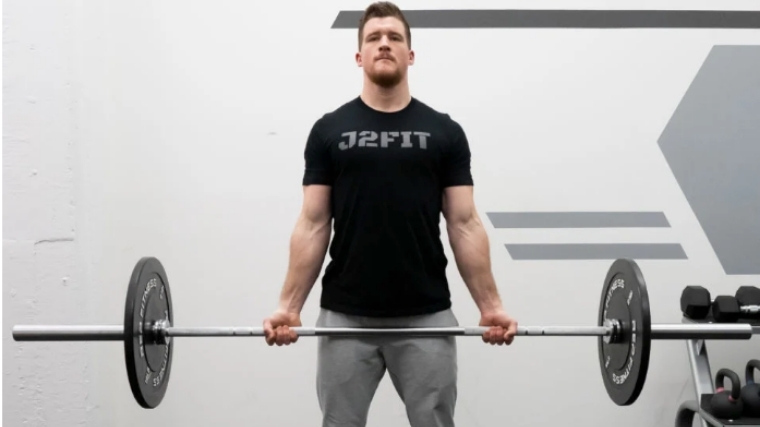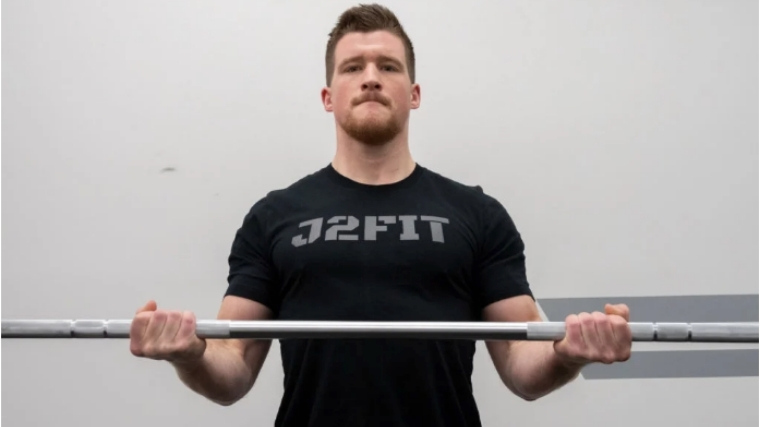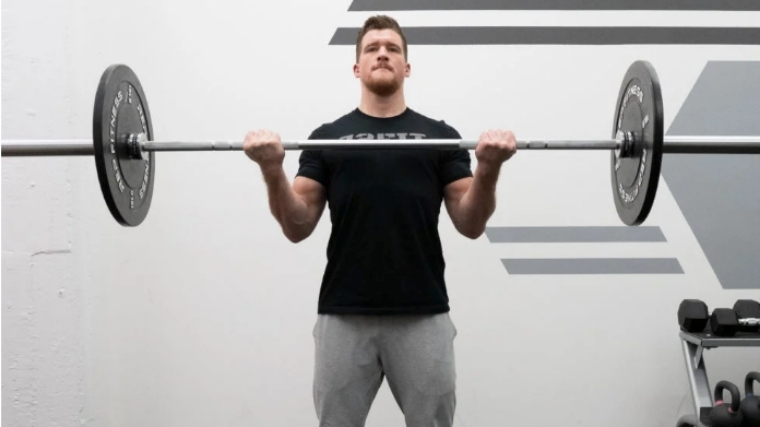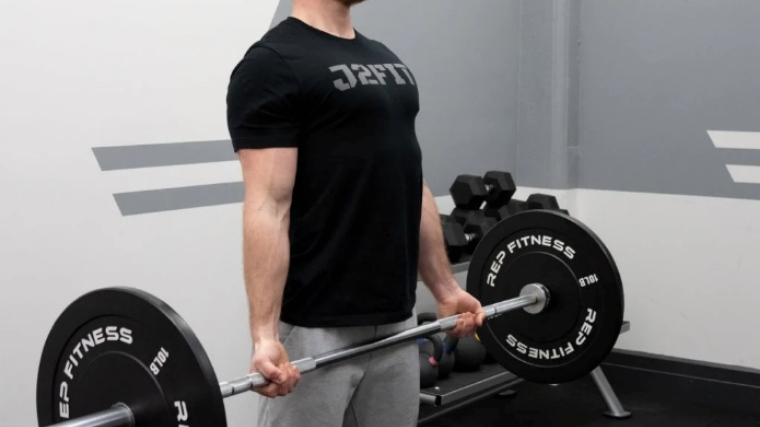Biceps training may take a back seat to more popular strength moves like back squats, deadlifts, and overhead presses. It’s true that you want to prioritize those compound moves in your workout split, but you may want to let barbell curls ride shotgun. (Ok, that’s the last car pun.)
Besides looking good — because a pair of meaty arms are aesthetic — bigger biceps serve some practical functions, too. The biceps muscle is a key player in most pulling exercises. Anytime your pull a heavy deadlift, your biceps are involved. The same is true for pull-ups, barbell rows, and more. Strengthening the biceps will carry over to those moves as well as help protect them from injury.
Here’s what you need to know about doing the barbell curl — a tried-and-true size and strength builder for the biceps:
- How to Do the Barbell Curl
- Benefits of the Barbell Curl
- Whats Muscles the Barbell Curl Works
- Who Should Do Barbell Curls
- Barbell Curl Set, Rep, and Weight Recommendations
- Barbell Curl Variations
- Barbell Curl Alternatives
- Frequently Asked Questions
How to Do the Barbell Curl
Theoretically, the barbell curl is simple to do. There’s more nuance to it than one may think. Here’s how to really lock in your form.
Step 1 — Stand Up Tall
Stand erect with the shoulder blades down the back, chest up, and shoulder pulled back. The grip should be slightly wider than hip-width (can vary), with the palms facing away from the body.
Form Tip: A lot of lifters will let the shoulder get pulled forward, almost hunching forward. Be sure to pull the chest up high and keep the shoulders back to expose the full bicep to the load.
Step 2 — Squeeze the Bar
This is something so few lifters do, and as a result, they flare their elbows out and leave a rep (or two) in the tank. the chest collapsing, and the biceps lacking width and fullness. Squeezing the bar will activate all of the muscles in your forearms and upper arm, which will generally activate the target muscles more. Also, you’ll be tight and less prone to flaring your arms out or performing generally sloppy reps.
Form Tip: Squeeze the pinkies on the barbell, like you are going to snap the bar. This will help to activate the rest of your grip.
Step 3 — Curl Up and Slightly Out
Instead of dragging the bar up the body, think about keeping the elbows slightly in front of the body at all times. Imagine yourself curling from a side view — your elbows should travel slightly in front of your torso. Continue to curl up, focusing on not letting the shoulders come forwards. Your shoulders will slightly — slightly! — come into to play when your elbows drift forward. Remember to primarily curl with your biceps. The point of letting your elbows come forward a bit is to further isolate the biceps.
Form Tip: Think about squeezing your shoulder blades together and keeping your chest up. Otherwise, you risk slouching forward and disengaging your biceps.
Step 4 — Find the Contraction and Hold it
Seems obvious, right? Well, if you lift too quickly or raise the barbell past the point of contraction, you’ll miss out on the whole point of the exercise — to engage your biceps. Curl the bar until it’s about an inch or two from the front of your shoulders. This is just a suggestion. Really, curl until you feel your biceps contract the most. Find that spot, hold the weight there for a beat, and then find that spot again on your next rep. The goal here is about gaining a contraction. If that means the bar is raised a little lower than what’s considered “normal” then that’s fine.
Form Tip: Actively flex your biceps throughout the entire movement, especially at the top.
Step 5 — Control the Bar on the Way Down
The work doesn’t end when you get the bar up — that’s just half the exercise. Lowering the barbell slowly (like to a count of two to three seconds) will tax more muscle fibers. Your muscle is still under a load, so there’s still an opportunity to breakdown muscle tissue in the biceps and build more mass. Don’t relax. Lower that bar slowly.
Form Tip: Think about having your hands finish slightly in front of the body like you are giving inconspicuous low hanging high fives.
4 Benefits of the Barbell Curl
Below are four benefits of the barbell curl that strength, power, and fitness athletes can benefit from.
1. Improved Grip Strength
The barbell curl can be done to help improve grip and arm strength, both of which can impact pulling strength and performance. Your biceps are moving the weight, but your hands, wrists, and forearms are supporting it All those secondary muscles will be taxed and you’ll have a crushing grip as a result.
2. Injury Prevention (to the elbows/arms)
The biceps are responsible for elbow flexion as well as supporting the grip muscles in pulls and loaded carries. Weak and underdeveloped biceps can cause grip issues, strain to the biceps, and in some cases muscle tears. A stronger biceps is a more resilient biceps. Hey, not every benefit has to do with filling out your shirt.
3. Increased Upper Body Mass
But it is nice if you can fill out your shirt, and the barbell curl can help if that’s your goal. Anytime you stress a muscle, it will respond by building itself back up to be bigger and stronger. (Assuming that your macros are dialed in, and you’re eating right. Diet is key.) While the biceps is the muscle you want to target and should be working with this exercise, your chest, shoulders, and traps even will come into play a little.
Also, the barbell curl can be loaded up with relatively more weight than other curling exercises. That means you can load the muscle faster and progress for longer without hitting a plateau.
4. They’re Accessible
Whether you own a barbell, a pair of dumbbells, or even a quality kettlebell — you can curl! You don’t need to haul a cable machine into your home gym to build a set of Larry Scott-like sleeve-huggers. You can do barbell curls in about a square foot if you really needed to. They’re simple and easy to execute.
Muscles Worked
The barbell curl is a single-joint accessory/hypertrophy exercise that can be highly effective at targeting the arms, specifically the muscles below.
Biceps
You know this, of course, but here’s some biceps knowledge you may not be privy to. Your biceps has one function, and that’s to flex your elbow (meaning bring your lower arm towards your face). Think about that for a second, and you’ll realize that your biceps are good for a lot more than just curling weights.
You need your biceps to pick up your kid (or cat), get that Friday night beer to your lips, and chuck that pigskin a quarter-mile like Uncle Rico.
Forearms
Your biceps are the mechanism that move the curling bar, and your forearms are what support it. The forearms aren’t a primary player in the biceps curl, but they’re just as important. Also, as your curl heavier weights over time, you should notice an increase in both forearm size and grip strength.
Who Should Perform Barbell Curls?
The barbell curl can help increase overall arm and grip strength and upper body mass for strength, power, and fitness athletes. In addition, the barbell curl can be done to offer added injury resilience and performance training for lifters who may be susceptible to bicep and elbow injuries.
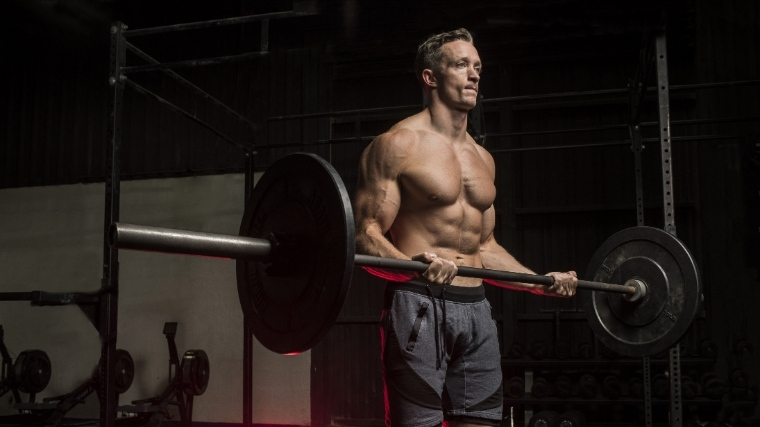
Strength and Power Athletes
Strength and power athletes can use the barbell curl, primarily to improve arm and grip strength, enhance eccentric loading potentials (injury prevention from strains and tears) during heavy deadlift and pulling training. Here’s more about how stronger biceps can help in specific strength sports:
- Strongman: Strong biceps can play a big role in injury prevention and grip strength during heavy pulls, farmer’s carries, truck pulls, and more.
- Powerlifting: Like strongman athletes, strong biceps can impact pulling strength and performance, especially helping to resist bicep strains and tears.
- Olympic Weightlifting: While weightlifters don’t want to pull with the arms during snatches and clean & jerks isn’t something we want in most lifts, stronger arms, in general, can increase pulling and grip strength. Having strong arms can also help during the pull under phase as well.
Bodybuilders
Bodybuilders strive to put on as much muscle as possible onto their frame while losing fat. In bodybuilding, every muscle is on display, so these athletes pay as much attention to their biceps as they do their back training or chest workouts. The barbell curl can be loaded heavier than other biceps for more overall growth, so it’s a great choice for those looking to sculpt their physique.
General Lifters
General lifters will benefit from the two reasons mentioned above. Even if they don’t need the size of a bodybuilder or strength of a strongman, everyday gym-goers can still strive for more mass and strength. It’ll help with their general gym performance, confidence, and biceps mobility.
Barbell Curl Sets, Reps, and Weight Recommendations
Below are two primary training goals and programming recommendations when programming barbell curls into training programs.
To Gain Strength
How you structure your volume (sets and reps) will determine whether you gain more strength or muscle. If you’re looking to increase the strength of your biceps, then we suggest performing more sets for fewer reps. That said, you don’t want to lift too heavy (less than four reps). The biceps are a small muscle, and if you try and lift too much you can risk injury.
Do four to six sets of four to eight repetitions. Remember to start with lighter weight and perform one to two warm-up sets before increasing the weight on the bar and going for broke. Compared to the muscle-building sets below, the volume here is lower. But that’s because lifting heavier weights is fatiguing to both your muscles and nervous system. Put simply: it’s harder!
To Build Muscle
Want bigger arms? Then you need to leave your ego at the door and focus on the contraction. This means lowering the weight on the bar and performing the barbell curl slowly and with intention. A goo rule of thumb is to use a weight that you can perform for two more reps than your target reps.
Aim to do five to eight sets of eight to 15 repetitions. Again, perform a couple of warm-up sets until the movement feels fluid and you’re ready to crush your working sets.
Barbell Curl Variations
Below are three barbell curl variations that can be done to improve strength, size, and overall muscle growth. Also, check out our YouTube video for even more variations.
[Related: Here’s How Often You Should Train Your Arms]
Eccentric Barbell Curls
The eccentric curl is a way to overload the biceps and creates massive amounts of tension on the tissues. Eccentric training and the eccentric aspect of muscle contraction (lengthening under load) has been shown to result in high amounts of DOMs and muscle growth. To do this, curl the weight up (you can have a partner help you) and slowly lower the load under control, and on a tempo (such as three to five seconds down).
Drag Curl
The drag curl has you hold the bar against your body for the duration of the movement so that you’re “dragging” it up to your chest. This variation locks your arms into place and creates an immense amount of tension on the biceps. Though, know that you can’t curl nearly as much weight with this variation. We suggest using this move as a finisher towards the end of your workout.
Seated Barbell Curl
The seated curl is a partial range of motion barbell curl, as it often omits that bottom segment of the range of motion. This exerciser can be effective at increasing the loading on the bicep as well as isolating the upper aspects of the biceps.
Barbell Curl Alternatives
Below are three barbell curl alternatives that can be done to vary programming, challenge lifters, and more.
Hammer Curl
The hammer curl is a curl variation that targets the biceps and the forearms at a slightly different angle, adding another dimension to your arm training and development. Often, this is done with dumbbells, so that the wrists can be turned curled in a neutral position.
Preacher Curl
The preacher curl is a biceps curl variation that can be done with the barbell, dumbbells, EZ bar, or machine (just to name a few). This exercise has the lifter place the arm at an angle, on a preacher curl bench, with the arm and shoulder supported on a pad (to minimize movement), to help isolate the bicep completely.
Chin-Up
The chin-up is still one of the best exercises to build overall biceps strength and size. If a lifter is lacking size and strength of the biceps and cannot do chin-ups (for volume), there’s a good chance that’s exactly why they don’t have large and strong arms…so start here.
Frequently Asked Questions
When should I do barbell curls in my routine?
It depends. If you train arms on a separate day, then do them early on. You can lift the most weight with your biceps on barbell curls, and you’ll be stronger at the start of your training session. If you train biceps with another muscle — like your chest or back — then you should save it for later in your workout. That said, still lead your biceps training off with this, just after chest or back work.
Can I do just barbell curls for my biceps?
Technically yes, but we don’t suggest that. All curls involve moving your lower arm up and down, so we can see why you think you only need one exercise. That said, there’s an advantage to using dumbbells, bands, and cables. Also, changing your hand position and arm angles are ways to keep your training fresh while changing the “feel” of an exercise.
Curls are simple, so I can sip my workout right?
No! Your biceps are a small muscle and just as injury prone as other, larger muscles. Before curling — especially if you plan to lift heavy — be sure to curl light weight for a few sets. Do two to three warm-up sets and add a little weight to each set. After you’ve done those, you can begin your working sets.
More Arm Training Tips
Biceps make up just half the arm. Here are some more complete arm training tips in your quest for some serious pythons.
- Arm Training – Powerlifters vs Bodybuilders
- Powerlifting Arm Workout Program
- 3 Arm Workouts for Weightlifters and Fitness Athletes
Featured image: Paul Aiken/Shutterstock
